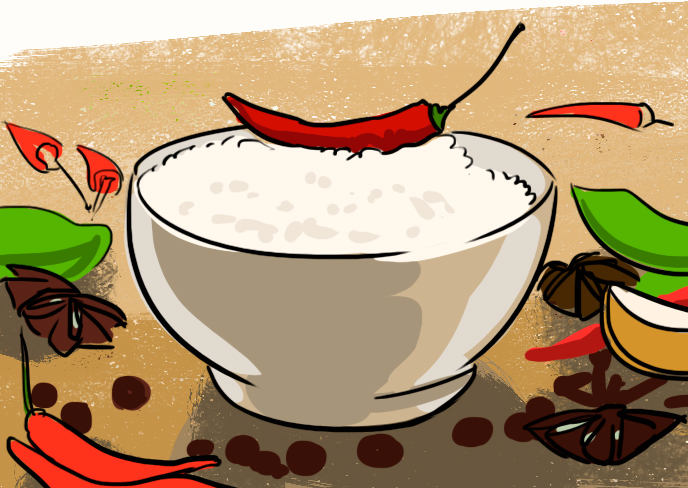Even the most sophisticated gourmets can not resist a wide range of spices and astounding set of ingredients of Indian cuisine. But it is interesting that the food in India is also an integral and important part of the culture.
India is the country with a mysterious and exotic culture. The legacy of "the mother of all civilizations," is extremely rich and the food is given a considerable role. The food is consecrated by tradition, that is still honored. In India, cooking is not only an art, but also a philosophy.

In the Vedas - the ancient religious books of the Hindus - the science of nutrition occupies an important place. According to the Vedas, all the dishes are divided into three groups, corresponding to the three states of nature: goodness, passion and ignorance. Ignorance implies overdone, very spicy food, too cold or too hot. Passion Food is a very spicy food, supersaturated with strong excitatory substances. Goodness Food is the one in which everything is in moderation. The dishes are not too spicy and not too salty, not too cold, not too hot, not too fatty. That is right, according to the laws of Vedic cuisine, energy-balanced diet.
India has the oldest, the most sophisticated and complicated cooking technique that ensures the presence of the five taste qualities: sweet, salty, sour, pungent and astringent. The sweet taste gives a feeling of fullness, while sour components indicate the presence of vitamins and minerals. Spice (spicy taste) have healing qualities. Imparting components, giving astringent taste to the food, help to get rid of metabolic products and reduce the formation of fat in the body.
Next, Indian dishes are classified into "cooling" and "heating", because it is important to maintain the proper temperature balance and avoid excess heat in the human body. Today, Indian cuisine is one of the most remarkable in the world. In terms of diversity and quantity of the various traditions that it absorbed, it can be compared with the French and Chinese only. Indian housewives, when cooking food, use more than 30 kinds of spices. With various combinations thereof dishes acquire subtle spicy flavor, resulting from the variety of flavors.
From the point of view of the Indians, the food is a gift of the gods to people. That is why cooking demands respect and attention and quite complicated preparation. For many hours women pound, chop, sieve and meter. Moreover, they calculate what food is useful today, what is forbidden, what food is better to cook during this time of year, and even in what phase of the moon. At full moon, every food is good, but in the dark phase of the moon in many parts of India, a strict fast is being kept. Considering the fact that most Indians are vegetarians, fasting for them is not a rejection of meat, but a way to switch to other products. Those who love rice, must be satisfied with the fruits of sago palms. Sometimes spices are also banned. Nuts, bananas, potatoes replace everything else.
Despite the existence of three and a half thousands of castes with their own policies governing the food, only two religions - Hinduism and Islam - have influenced the culinary habits of Indians. It is interesting that, following their confession, even members of one family can eat separately. Muslims, inhabiting mainly the northern states, do not eat pork, and supporters of Hinduism do not eat beef. It is believed that India is the birthplace of vegetarianism. The tradition of not eating meat is partly due to climatic conditions: in most parts of the country there is hot climate, the meat is perishable, while in some areas, people collect three or four crops of vegetables a year. However, meat is not eaten mainly for religious reasons.
India is a home to a huge number of spices. For the sake of spices, Christopher Columbus set out to find a new route to India and discovered America. The spices give Indian cuisine peculiar and special flavor. Indians use the well-known coriander, cumin, cloves, cardamom, cinnamon, turmeric, red and green chili, saffron, nutmeg, ginger, anise and many others, as well as lots of exotic spices, for example, mango powder and asafoetida.
The Indian subcontinent offers a diverse range of exotic spices and herbs. This diversity, as well as countless combinations and extensive use of spices in Indian cuisine is distinguished from any other cuisine in the world. Indian art of using spices and choice of ingredients is very flexible and varies depending on the region and the cook. Especially popular is the usage of curry spices. The name of this spice comes from the Indian word kari (sauce). This thin and delicate mixture is made of red and black pepper, nutmeg, cinnamon, cloves, ginger, nuts, mustard, mint, mayonnaise, parsley, dill, garlic, saffron, onions, tomatoes and other condiments. Among other special sauces are: hot sauce Acar, cooked from fruit with spices and red hot sauce massalha. The variety of Inidan sauces is not so big, but you can easily change the recipe a bit and get the other variation of sauce.
All national Indian dishes are prepared with onions, garlic and lots of pepper. Spices - this is something that unites India's regions and at the same time diversify their kitchen. The Indian cook keeps approximately 25 fresh spices on hand, using which he makes a unique bouquet of flavors. Many medicinal herbs possess properties. However, each region has its own favorite spices and combinations thereof.